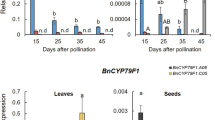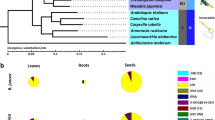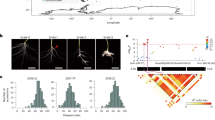Abstract
Aliphatic glucosinolates are thioglucosides synthesized by genera within the Capparales including Arabidopsis and Brassica. They have been shown to mediate pest or pathogen interactions and to reduce the feeding quality of rapeseed meal. Their biological activity is largely dependent upon the structure of the side chain which determines the nature of hydrolysis products produced following tissue damage. A generalized model of the biosynthesis of aliphatic glucosinolates is proposed and tested with reference to the genetic regulation of side chain length by analysing recombinant populations of B. napus and A. thaliana developed from parental lines which varied in their glucosinolate content. The results of the B. napus studies were consistent with a model in which alleles at a single locus (Gsl-pro) regulate the presence or absence of propyl glucosinolates, and those at two other loci ( Gsl-elong-C and Gsl-elong-A) (which map onto a pair of homoeologous linkage groups, one from the C genome and one from the A genome) regulate side chain elongation of the amino acid derivative which results in the production of butyl and pentyl glucosinolates. As null alleles do not occur at the Gsl-elong-A locus, the proportion of propyl glucosinolates is limited to below 30 per cent of total aliphatic glucosinolates. Alleles at a single locus in A. thaliana (Gsl-elong-Ar), which maps 1.3 cM from the RFLP locus m291 on chromosome 5, regulate side chain elongation of aliphatic glucosinolates in this species. It is suggested that the Gsl-elong-Ar gene is homologous to the Gsl-elong-A and Gsl-elong-C genes and, if cloned, could be used to down-regulate the endogenous Gsl-elong genes in B. napus.
Similar content being viewed by others
Article PDF
References
Chew, F S. 1988. Biological effects of glucosinolates. In: Cutler, H. G. (ed.) Biologically Active Natural Products-Potential Use in Agriculture, pp. 155–181. American Chemical Society Symposium, Washington DC.
Chisholm, M D, and Matsuo, M. 1972. Biosynthesis of allylglucosinolate and 3-methylthiopropylglucosinolates in horseradish, Armoracia lapathifolia. Phytochemistry, 11, 203–207.
Fenwick, G R, Heaney, R K, and Mullin, W J. 1983. Glucosinolates and their breakdown products in food and food plants. Cut Rev Food Sci Nutr, 18, 123–301.
Foisset, N, Delourme, R, Lucas, O M, and Renard, M. 1993. Segregation analysis of isozyme markers on isolated microspore-derived embryos in Brassica napus L. Plant Breed, 110, 315–322.
Haughn, G W, Davin, L, Giblin, M, and Underhill, E W. 1991. Biochemical genetics of plant secondary metabolities in Arabidopsis thaliana. The glucosinolates. Plant Physiol, 97, 217–226.
Hogge, L R, Reed, D W, Underhill, E W, and Haughn, G W. 1988. HPLC separation of glucosinolates from leaves and seeds of Arabidopsis thaliana and their identification using thermospray liquid chromatography-mass spectrometry. J Chrom Sci, 26, 551–556.
Kosambi, D D. 1944. The estimation of map distance from recombinant values. Ann Eugen, 12, 172–175.
Lander, E S, and Botstein, D. 1989. Mapping Mendelian factors underlying quantitative traits using RFLP linkage maps. Genetics, 121, 185–199.
Lander, E S, Green, P, Abrahamson, A, Barlow, A, Daly, M J, Lincoln, S E, and Newburg, I. 1987. Mapmaker: an interactive computer package for constructing primary genetic linkage maps of experimental and natural populations. Genomics, 1, 174–181.
Lister, C, and Dean, C. 1993. Recombinant inbred lines for mapping RFLP and phenotypic markers in Arabidopsis thaliana. Plant J, 4, 745–750.
Magrath, R, and Mithen, R. 1993. Maternal effects on the expression of individual aliphatic glucosinolates in seeds and seedlings of Brassica napus. Plant Breed, 111, 249–252.
Magrath, R, Herron, C, Giamoustaris, A, and Mithen, R. 1993. The inheritance of aliphatic glucosinolates in Brassica napus. Plant Breed, 111, 55–72.
Mithen, R. 1993. Leaf glucosinolate profiles and their relationship to pest and disease resistance in oilseed rape. Euphytica, 63, 71–83.
Poulton, J E, and Møller, B L. 1993. Glucosinolates. In: Lea, P. J. (ed.) Methods in Biochemistry, vol. 9: Enzymes of Secondary Metabolism, pp. 209–237. Academic Press, London.
Stuber, C W, Lincoln, S E, Wolff, D W, Helentjaris, T, and Lander, E S. 1992. Identification of genetic factors contributing to heterosis in a hybrid from two elite maize inbred lines using molecular markers. Genetics, 132, 823–829.
Underhill, E W, Wetter, L R, and Chisholm, M D. 1973. BlO-synthesis of glucosinolates. Biochem Soc Symp, 38, 303–326.
Author information
Authors and Affiliations
Rights and permissions
About this article
Cite this article
Magrath, R., Bano, F., Morgner, M. et al. Genetics of aliphatic glucosinolates. I. Side chain elongation in Brassica napus and Arabidopsis thaliana. Heredity 72, 290–299 (1994). https://doi.org/10.1038/hdy.1994.39
Received:
Issue date:
DOI: https://doi.org/10.1038/hdy.1994.39
Keywords
This article is cited by
-
Exploiting natural variation for accelerating discoveries in plant specialized metabolism
Phytochemistry Reviews (2018)
-
Natural variation of root exudates in Arabidopsis thaliana-linking metabolomic and genomic data
Scientific Reports (2016)
-
Deciphering allelic variations for seed glucosinolate traits in oilseed mustard (Brassica juncea) using two bi-parental mapping populations
Theoretical and Applied Genetics (2015)
-
Engineering Glucosinolates in Plants: Current Knowledge and Potential Uses
Applied Biochemistry and Biotechnology (2012)
-
10.1007/BF00194757
CrossRef Listing of Deleted DOIs (2011)



